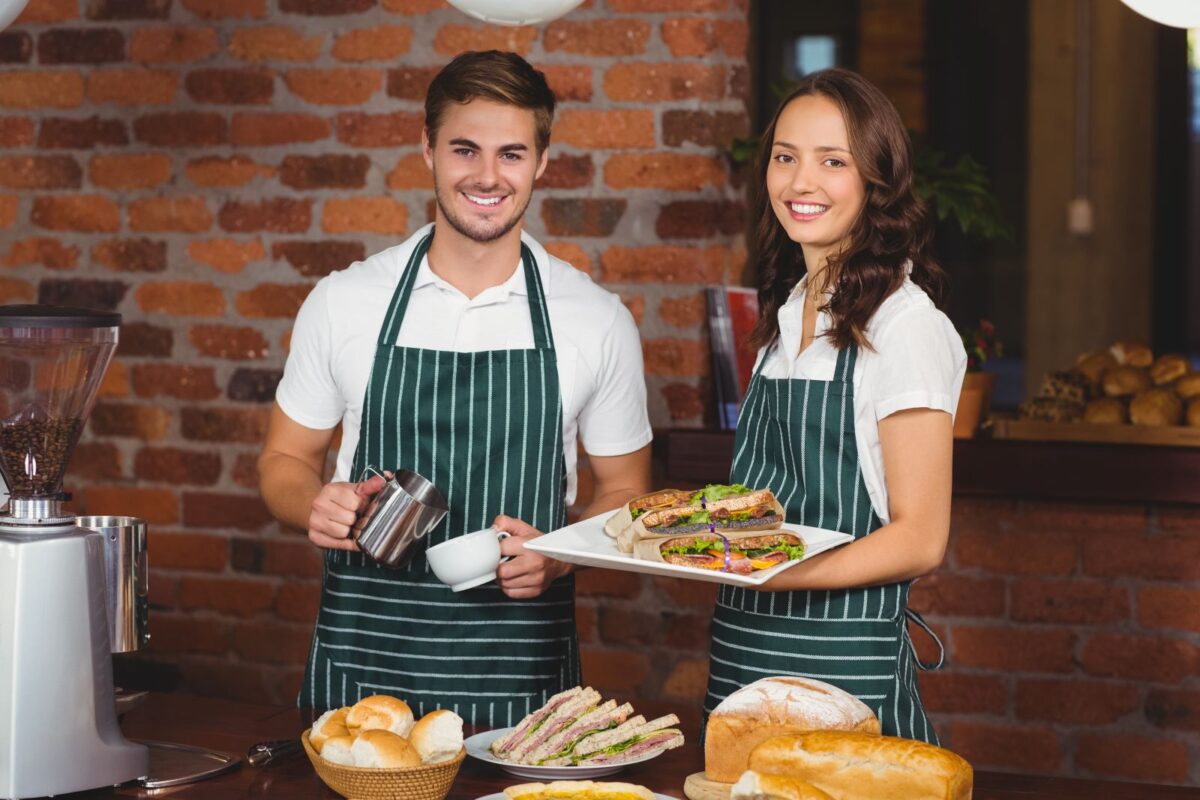Designing restaurant uniforms requires a thoughtful approach that balances brand identity, functionality, and employee comfort. Here are some ideas to inspire your restaurant’s look:
1. Reflect Your Restaurant’s Concept & Ambiance:
- Fine Dining: Classic and elegant. Think tailored suits or dresses in sophisticated colors like black, white, or deep jewel tones. Consider vests, ties, bow ties, and polished shoes. High-quality fabrics are key.
- Casual Chic: Relaxed yet stylish. Polo shirts, button-down shirts with rolled-up sleeves, or fashionable blouses paired with well-fitting trousers, chinos, or dark denim. Consider adding branded aprons or vests. Comfortable, stylish trainers or loafers can work for footwear.
- Rustic/Farm-to-Table: Natural and earthy tones like olive green, brown, beige, and denim. Think chambray shirts, linen fabrics, and durable canvas aprons. Boots or comfortable closed-toe shoes complement this look.
- Modern/Trendy: Edgy and contemporary designs. Consider asymmetrical cuts, unique color combinations, and interesting textures. All-black outfits with a pop of color in aprons or accessories can look striking.
- Themed Restaurants: Uniforms should directly reflect the theme. For a 1950s diner, think poodle skirts and soda jerk hats. For an Italian trattoria, consider checkered shirts and bistro aprons.
- Fast Casual: Comfortable and practical. Branded t-shirts or polo shirts are common, paired with comfortable pants or shorts. Hats or visors can also be incorporated.

2. Key Uniform Components & Design Elements:
- Tops:
- Shirts: Button-down, polo shirts, t-shirts, blouses – consider short-sleeved, long-sleeved, or 3/4 sleeves based on the role and climate.
- Chef Coats/Jackets: Essential for kitchen staff, offering protection and a professional look. Consider different styles (double-breasted, single-breasted), sleeve lengths, and colors.
- Vests: Add a layer of sophistication and can differentiate roles (e.g., servers vs. hosts).
- Sweaters/Cardigans: Useful for cooler environments or for a layered look.
- Bottoms:
- Trousers: Tailored, chinos, cargo pants – choose based on the formality and practicality needed.
- Skirts/Dresses: Options for front-of-house staff in more formal or themed settings. Consider length and practicality.
- Jeans: Dark wash or black jeans can work for casual or trendy establishments.
- Aprons:
- Bib Aprons: Offer full coverage and often feature pockets.
- Waist Aprons: A shorter style, practical for servers.
- Materials: Consider durable fabrics like canvas, denim, or stain-resistant blends.
- Customization: Add your logo or brand colors to aprons.
- Headwear:
- Chef Hats: Traditional toque, skull caps, beanies, baseball caps – functional and part of the kitchen uniform.
- Hairnets: Essential for hygiene in the kitchen.
- Visors/Caps: Can be used for casual or outdoor dining staff.
- Scarves/Bandanas: Can add a touch of style and reinforce the brand’s color scheme.
- Footwear:
- Comfort and Safety: Non-slip shoes are crucial for all staff.
- Style: Choose styles that align with the overall uniform (e.g., polished leather shoes for formal, clean trainers for casual).
- Accessories:
- Name Tags: Essential for customer interaction. Consider different materials and attachment styles.
- Ties/Bow Ties: Add formality to front-of-house uniforms.
- Belts: Can create a more polished look.
- Cufflinks/Pins: Subtle ways to add brand identity or a touch of elegance.
3. Current Trends in Restaurant Uniform Design:
- Sustainability: Eco-friendly materials like organic cotton, recycled polyester, and bamboo are gaining popularity.
- Comfort and Functionality: Breathable, stretchable fabrics and ergonomic designs are prioritized for staff well-being.
- Customization and Personalization: Restaurants are looking for unique uniforms that reflect their brand. This includes custom colors, logos, and even allowing for some individual expression within guidelines.
- Athleisure Influence: Incorporating elements from sportswear for comfort and ease of movement. Think performance fabrics and relaxed silhouettes.
- Bold Colors and Patterns: Moving beyond traditional monochrome to make a statement and enhance brand recognition.
- Gender-Neutral Designs: Offering more inclusive and versatile uniform options.
- Vintage and Retro Styles: Drawing inspiration from past eras to create a unique and nostalgic feel.
- Minimalist Aesthetics: Clean lines, neutral colors, and a focus on quality.
4. Practical Considerations:
- Durability and Washability: Uniforms need to withstand frequent washing and the demands of a busy restaurant environment. Choose easy-to-care-for fabrics.
- Comfort in Different Climates: Consider the local weather and choose fabrics that will keep staff comfortable in both hot and cold conditions.
- Budget: Balance your design aspirations with your budget for purchasing and maintaining the uniforms.
- Employee Feedback: Involve your staff in the selection process to ensure they are comfortable and feel good in their uniforms. This can boost morale and professionalism.
- Role Differentiation: Ensure that different roles within the restaurant have distinct uniforms or elements to easily identify staff members for customers.
By considering these ideas and tailoring them to your specific restaurant concept, you can create a uniform program that not only looks great but also enhances your brand image and provides a comfortable and functional solution for your team.

